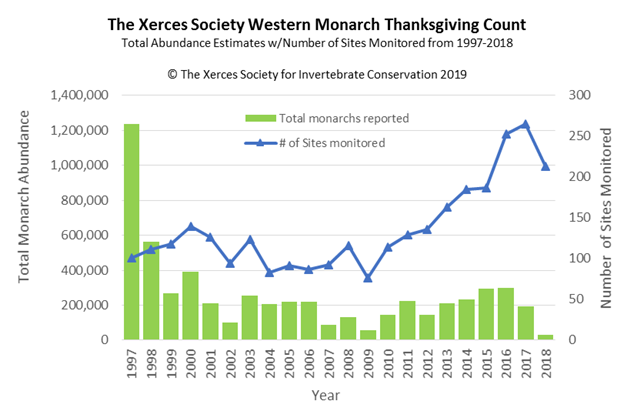New science shows Western Monarch Butterflies down to 1% of historic population
SACRAMENTO — Local elected officials, environmental activists and scientists are sounding the alarm bell to save the last of the monarch butterfly after the latest research indicated that there are less than 1% of the population remaining in California. The groups called on individuals, mayors, and the state to take action now.
“Western Monarch butterflies are not only an iconic species in California, they are also an indicator species that is helping us begin to understand the impact we are having on the habitats that monarchs, as well as native bees, beetles, and birds, depend on to survive” said California Assemblyman Mark Stone (29th District), who authored AB 2421, California’s Monarch Butterfly and Pollinator Rescue Program.
“Pollinators are critical to ecosystems around the world, and the concerning bee die-offs have been prevalent in the media lately,” said Sacramento City Council Member Jeff Harris, “but the latest monarch population numbers are truly shocking and California’s location positions the state to take a key role in reversing this crisis.”
According to the Xerces Society, researchers and citizen scientists estimate that the overall monarch population has declined a staggering 80 percent over the past two decades. In the west, the news is even more dire. Monarchs have experienced a decline of 99.4 percent, from an estimated 4.5 million in the 1980s to 28,429 as of January 2019.
“The western monarch population has been declining since the 1980’s, but the sharp drop in numbers this year is alarming,” said Angela Laws, Monarch and Pollinator Ecologist at Xerces Society. “The smaller the population gets, the more vulnerable it is to becoming extinct. We are hopeful that this news will spur meaningful action to protect these amazing insects.”
Environment California is encouraging action to save the monarch butterfly. The group has a list of 5 things that people can do to help save the butterflies.
-
Plant Native Milkweed — Monarchs only lay eggs on this one plant, and increasing herbicide use and development across the country are wiping it out.
-
Plant Native Nectar Plants — While milkweed is important, monarchs also need to eat. Nectar plants are essential for monarch survival, so plant both milkweed and nectar flowers.
-
Contribute to Citizen Science — You can help improve our understanding of current monarch population and migration data through your own careful observations. Simply enter your observations into the online Monarch Joint Venture database.
-
Stop Using Insecticides and Herbicides — Not only do these products typically harm monarchs, but they can also be deadly to the plants on which monarchs rely.
-
Spread the word!
In addition to us each taking individual actions, we need our leaders to step up. The Xerces Society is advocating for more protection around monarch habitat in California.
Here are the 3 things the State can do.
-
Protect and Manage California Overwintering Sites — This means immediately stopping destruction of overwintering sites throughout California, and then working to create and implement site management plans.
-
Restore Breeding and Migratory Habitat in California — The Sacramento Valley, Sierra Nevada Foothills, and Coast Range are vital to the survival of the first generation of monarchs produced in the spring.
-
Protect Monarchs and their Habitat from Pesticides — Adopt integrated pest management plans that call for toxic pesticides as a last resort, or better, phase pesticides out entirely.
“We have the solutions but we don’t have time to waste,” said Emily Fieberling, Conservation Associate at Environment California. “Everyone needs to take action right now to ensure that this year’s extraordinary monarch migration isn’t the last.”


##-##-##
For more information please go to https://xerces.org/save-western-monarchs/

